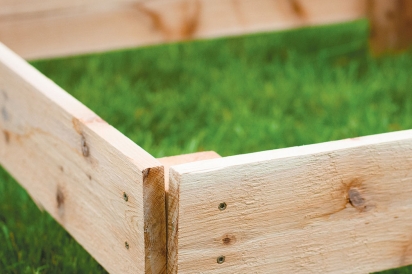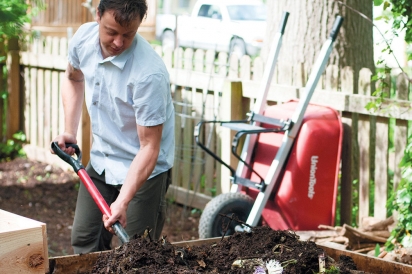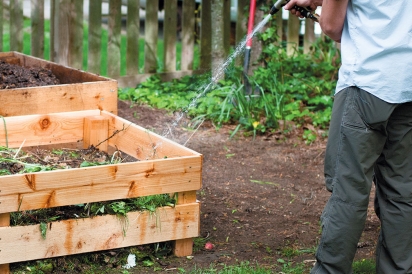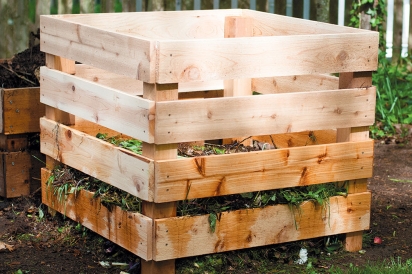DIY Compost 101
We know. You want to compost. But where to begin? The Seasoned Farmhouse Chef Joshua Wickham builds his own homemade cedar compost bin to stack in the backyard, making his composting efforts easy and economical. The cedar compost bin can outlive a compost barrel and be repurposed for raised beds, making an excellent bed for growing potatoes because of the height and depth it offers.
Josh lays out the blueprint for how to build the compost bin and how to prepare the right amount of nitrogen to carbon and water to oxygen so your compost really cooks! It’s a science but not one meant to mystify you. Josh includes resources for building up healthy compost over time. So save your scraps and backyard debris get to it.
What You’ll Need for A 4 Tier 3- by 3-foot Stackable Compost Bin
16 each 6- by 1-inch cedar planks cut to three-foot sections
16 each 4- by 4-inch cedar posts cut to 8 inches
64 each 2-inch deck screws (note: use star head or torx screws instead of Phillips head to allow for ease when screwing into the cedar plank and post)
Build It Up
Construction Time: approximately 1 hour
It is important to use only cedar for this construction as it does not easily rot and it will not be consumed by insects. Red cedar can be obtained from just about any hardware store with a lumber yard. My personal preference is Menard’s; they have a wonderful lumber selection.
Step 1: Form a square by screwing 4 planks to the 4 corners posts leaving 1 inch of the plank open at the top. This will leave 3⅜ inches of the post exposed below the plank. Use two deck screws for each plank at each corner. This will allow the next frame to sit firmly atop the lower.
Step 2: Repeat with the next three frames.
Step 3: Filling the Compost Bin When filling the compost bin there are four major ingredients to concern yourself with: Carbon, nitrogen, oxygen and water. These four factors are essential for healthy fast moving compost.
Carbon and Nitrogen: The ideal ratio of carbon to nitrogen is one part nitrogen to three parts carbon. A great way to ensure the proper ratio is by using a five gallon bucket when filling the compost bin. You will need one bucket of nitrogen contributors to every three buckets of carbon contributors. By keeping a small pile of carbon contributors next to the bin you can add as necessary to balance any added nitrogen contributors. (Note: If your compost is mostly leaves and in need of nitrogen but you don’t have the food scraps, you can buy nitrogen at the garden store to add to your compost pile.)
Nitrogen Contributors Fish meal, fish scraps, blood meal, alfalfa and pea clover, green garden waste, algae and seaweed, coffee grounds and filters, lake moss, hair, kitchen fruit and vegetable scraps and spring grass clippings.
Carbon Contributors Straw, dried leaves, sawdust in small amounts, wood chips in small amounts, shredded newspaper, cardboard, dryer lint, corn stalks and corn cob, shredded brown paper grocery bags, pine needles and pine cones and egg shells.
Oxygen: Another factor to consider is aeration. This can be achieved by layering your bin with small twigs and sticks every 10 or so inches as you add the other ingredients. The twigs will create space between the layers allowing air to circulate.
Water: Water activity in the pile is also an important factor. The compost material should feel like a wet sponge. Water the pile with the garden hose when initially constructed. If the weather is dry for extended periods, interment manual watering may be necessary.
Step 4: Turning the Compost Turning the compost regularly is import to introduce air into the pile and redistribute the ingredients allowing for an even decomposition.
Allow the compost pile to sit for 2 to 3 weeks to cook before turning it. You can turn it by removing the top most frame to the side and shoveling the compost pile into the frame. Repeat with the other three frames and compost. It takes about a ½ hour to turn the compost.
Compost will cook for approximately 2 months (8 weeks), requiring 3 good turns. When it’s cooked and ready to leave the compost bin it can be spread for mulch in the garden, worked down to be used as potting soil and repurposed for raised beds.
Resources for Cooking Good Compost
Great Books
The Complete Compost Gardening Guide: Banner batches, grow heaps, comforter compost, and other amazing techniques for saving time and money, and ... most flavorful, nutritious vegetables ever, by Deborah L. Martin
Let it Rot!: The Gardener’s Guide to Composting (Third Edition), by Stu Campbell
Great website for building different kinds of composters











